I'm trying to replace NaN values in df1 with values from df2. The 'replacement' value in df2 is located by two inputs, p/n and operation.
Because the desired NaN value in df1 is dependent on the P/N and Operation, looking up the value in df2 must contain both the P/N and Operation. Sorting df1 for the Nan values can be found using:
df1 = df1.loc[df1['Time'].isnull()]
Where finding the replacement value can also be located
`
df2 = df2.loc[(df2['P/N'] == pn) & (df2['Operation'] == op), 'Time']
`
The dataframes are too large to merge (plus there is a benefit to keeping them separate)...how can df2 be used as a lookup table for the 'Time' column in df1?
This post is similar but I had a difficult time understanding the solution, plus I'm unsure how to make lambda dependent on two lookup values: Pandas replace all NaN values with data from a different dataframe
Any help is appreciated.
*** UPDATE *** UPDATE *** Posting the code used to troubleshoot the issue, special thanks to Naveed for the help!
'''
df1 = pd.DataFrame(np.array([['10/25/2022', 'Apple',
'Wash','Joe','Washer','EA', 100, 100, 0, 0.25, 1.1, 90.91, 55],
['10/25/2022', 'Apple',
'Peel','Tom','Peeler','EA', 100, 95, 5, 0.25, 1.30, 73.08, pd.NA],
['10/25/2022', 'Apple',
'Package','Sally','Packing','EA', 95, 95, 0, 0.8, 5.0, 19.00, pd.NA],
['10/25/2022','Orange', 'Wash',
'Joe','Washer','EA', 100, 100, 0, 0.25, 1.1, 90.91, pd.NA],
['10/25/2022','Orange',
'Peel','Tom','Peeler','EA', 95, 95, 5, 0.25, 2.30, 41.30, pd.NA],
['10/25/2022', 'Orange',
'Package','Sally','Packing','EA', 95, 95, 0, 1.1, 5.30, 17.92,
pd.NA],
['10/25/2022','Banana', 'Peel &
Eat','Tom','Peeler','EA', 100, 100, 0, 0.25, 1.1, 90.91, pd.NA]]),
columns=['date', 'fruit', 'operation',
'operator', 'station', 'uom', 'pcs_processed', 'pcs_accepted',
'pcs_reject', 'setup', 'runtime', 'actual',
'target'])
df2 = pd.DataFrame(np.array([['Apple', 'Wash', 'EA', 0.25, 0.25, 96],
['Apple', 'Peel', 'EA', 0.33, 0.1, 11.63],
['Apple', 'Slice', 'EA', 1.25, 0.25,32],
['Apple', 'Package', 'EA', 2.0, 1.0, 16.0],
['Orange', 'Wash', 'EA', 0.25, 0.25, 96.0],
['Orange','Peel', 'EA', 1.0, 0.1, 43.64],
['Orange', 'Slice','EA', 0.25, 0.25, 96.0],
['Orange', 'Package', 'EA', 2.0, 1.0, 16.0],
['Banana', 'Peel', 'EA', 0.5, 0.25, 64.0],
['Banana', 'Slice', 'EA', 1.10, 0.25, 35.56],
['Banana', 'Package', 'EA', 1.50, 1.00,
19.20],
['Banana', 'Peel & Eat', 'EA', 2.0, 3.0, 22],
['Pear', 'Peel & Eat', 'EA', 1.3, 0.25,
6.5]]),
columns=['fruit', 'operation', 'uom',
'cycle_time', 'chng_time', 'target'])
# Set to multi-level index
df1.set_index(['fruit','operation'], inplace=True)
df2.set_index(['fruit','operation'], inplace=True)
# Update df1 with df2 'Time' values
df1.update(df2, overwrite=False)
# Reset df index
df1 = df1.reset_index()
df2 = df2.reset_index()
'''

